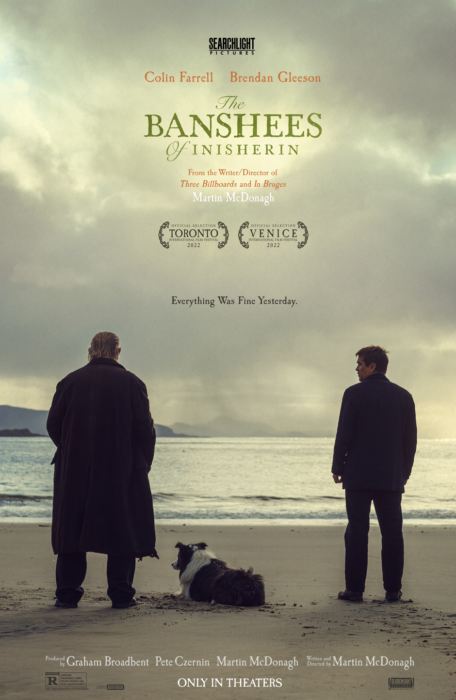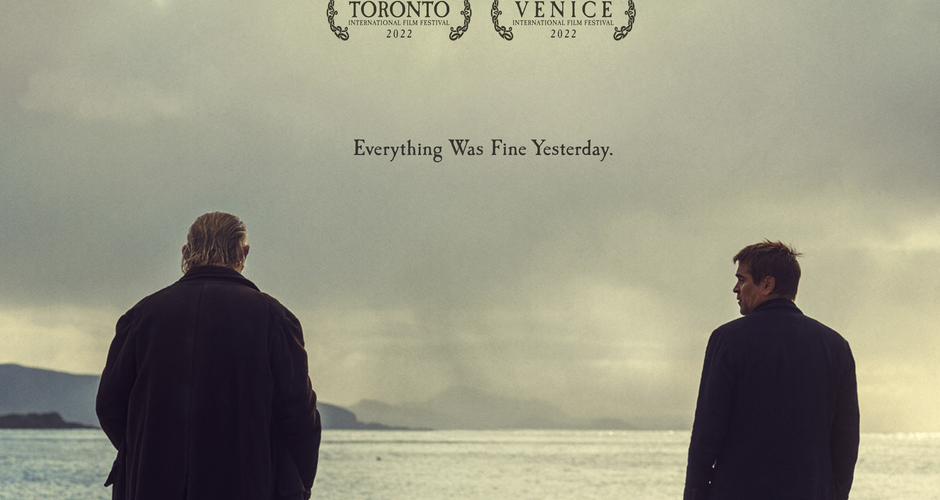
Preeminent Irish poet and dramatist William Butler Yeats perfectly captured the soul of his countrymen when he observed that, “Being Irish, he had an abiding sense of tragedy, which sustained him through temporary periods of joy.” And who better to bring Gaelic wit, wisdom and despair to the screen than playwright and film director Martin McDonagh (“In Bruges,” “Three Billboards Outside Ebbing, Missouri)” who, although born in England, was the son of Irish parents.
Both mordantly funny and achingly sad, THE BANSHEES OF INISHERIN takes place off the West Coast of Ireland – on a speck of an island that is close enough to the mainland that the villagers can hear and see the cannon fire and smoke from the Irish Civil War playing out across Galway Bay. Were it not for several references to that conflict and a 1923 calendar hanging on the wall of a cottage, viewers would have little to no sense of when the film takes place. The fictional island of Inisherin bears a passing resemblance to Brigadoon, the mythical village in the Scottish Highlands that rises from the mist once every hundred years.
Exuding humor and pathos in equal measure, THE BANSHEES OF INISHERIN concerns the abrupt end of a lifelong friendship and the toll it takes on both parties. Pádraic Súilleabháin Colin Farrell) may not be the sharpest knife in the drawer, but he is a gentle soul with a kind heart and sensitive nature who neither demands nor expects anything from life, other than a roof over his head (the small cottage that he and his sister Siobhán (a pitch-perfect Kerry Condon) grew up in and now share); a couple of pints of beer a day with his best friend Colm Doherty (Brendan Gleeson); and the companionship of his pet donkey Jenny. Every day at 2pm, Pádraic stops at Colm’s cabin and the two walk together to the village pub. One day, however, Colm not only fails to answer the knock on his door but refuses even to acknowledge Pádraic staring into his window, calling his name.
A baffled Pádraic arrives at the pub alone. When Colm does saunter in later, he reluctantly explains his odd behavior by simply stating, “I don’t want to be friends with you no more.” End of conversation! Colm later explains to Siobhán that,“your brother is dull.” The incredulous woman blurts out, “He has always been dull.”
Pádraic, of course, is utterly shattered by this turn of events, while Colm remains implacable, to the point of derangement, in his resolve to cut Pádraic out of his life. A gifted fiddle player and composer who is some 15 years older than Pádraic, Colm suddenly senses his life slipping away and wants to devote what time he has left to the pursuit of art, music and literature.
THE BANSHEES OF INISHERIN reunites Farrell and Gleeson, who starred opposite one another in McDonagh’s 2008 feature debut IN BRUGES, a delightfully engaging and sad (to the point of tears at one point) story about the relationship between two hitmen who have been sent to Bruges to kill someone. In both films,the chemistry between the two actors is a thing of wonder. As good as each actor has been in the numerous films each has undertaken over the years, there is something about their pairing in these two films that is magical. The exceptional cast also includes Barry Keoghan as the amiable but woefully dim-witted Dominic.
In Ben Davis’ restrained but expressive cinematography, viewers can feel, not just see, the wind-swept fields and thick fog that envelope Inisherin, while the lilting,soulful Irish score by Carter Burwell captures both the haunting beauty and the palpable pain that is the warp and woof of Celtic music. The story’s tone doesn’t so much shift from mordant humor to comic absurdity to mournful sorrow as it weaves the threads together. The film’s premise is simple — almost simplistic –while its plot is as thin as Oliver Twist’s gruel. Yet this film rises to the level of pure poetry.
